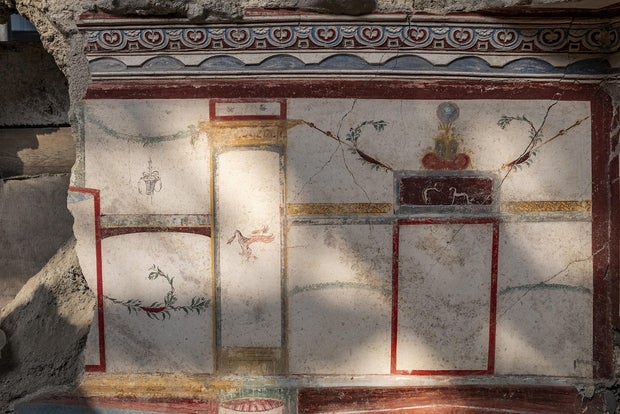Archaeologists in Pompeii have unearthed a rare small house while excavating the site of the ancient Italian city, officials said. The house was buried under the ash and rubble that swept away Pompeii when Mount Vesuvius erupted in 79 AD, but the elaborate frescoes painted on the interior walls remain largely intact.
The house came into view during an ongoing construction project in a part of the Archaeological Park of Pompeii called Insula dei Casti Amanti, or House of Chaste Lovers, the park said in a translated announcement. Its size was unusually small compared to others found in Pompeii, including some nearby, and what adds to the intrigue is the fact that it contains such lavish art.
Parco Archeologico di Pompei/Handout via REUTERS
The frescoes mainly depict scenes from classical mythology. A well-preserved painting of Hippolytus and Phaedra, two characters from a Greek tragedy, gave the house its provisional name: the House of Phaedra. Hippolytus and Phaedra also appear in a small painting found elsewhere in the house.
Beyond these characters, archaeologists discovered a fresco depicting an embrace between a satyr – another part-human, part-goat figure from Greek mythology – and a nymph, as well as one of a pair of deities thought to be Venus and Adonis. said the park. Another example could be an illustration of the Judgment of Paris, another Greek myth, although the scene was difficult to decipher because the fresco was damaged.
Parco Archeologico di Pompei/Handout via REUTERS
In the courtyard outside the house they found more works of art, including mainly illustrations of plants and animals, such as a bird of prey and two snakes facing each other. According to the park, the snakes lay around an altar and people would have made sacrifices there.
Some items from the last offering before the eruption were still there. Archaeologists discovered both a ceramic incense burner and a lamp, with traces of sprigs of fragrant essences detected by laboratory analysis. They also found colored marble and a sculpture of a face related to the Greek god Dionysus near the altar.
Park officials said the discoveries made at the ancient house, and the house itself, could shed light on some of the changes Roman society underwent during the first century AD, especially in Pompeii, because it is architecturally and stylistically different from his neighbors. A scientific article discussing the unusual layout of the house was published in the archaeological park’s digital magazine, focusing on Pompeii.









